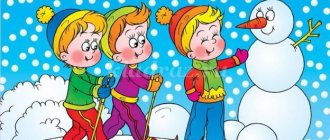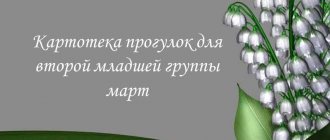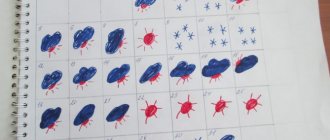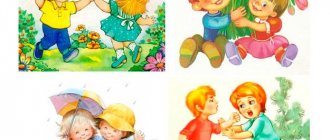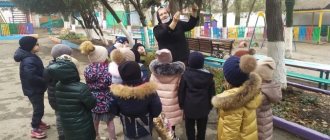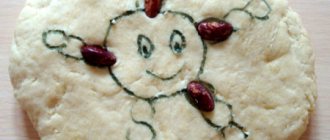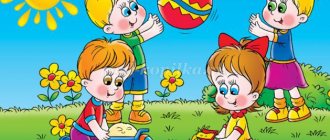Walks and observations in the summer in kindergarten
Consultation for educators on the topic:
Walks and observations in the summer
Author: Shchukina Natalya Yurievna, teacher of nursery/kindergarten No. 22 of a sanatorium type for tubi-infected children, Pavlodar Description of the material: I offer you a consultation for teachers of preschool institutions. This material will be useful to educators of all age groups. This material will help you properly plan and conduct walks in the summer. Consultation for educators on the topic: Walks and observations in the summer Each walk contains: -observations that form specific knowledge that develop thinking, interest and love for nature, a sense of beauty; - didactic games and experiments , which allow the child to consolidate knowledge about the world around him, give real ideas about the various aspects of the object being studied, about its relationships with other objects and with the external environment; - outdoor games that help relieve mental stress from activities and develop moral qualities; -an artistic word that helps children explore the world and develop curiosity. - labor education , which helps to master skills and abilities. The content and forms of labor organization depend on the weather and time of year. Summer opens up new opportunities to introduce children to nature: many changes occur in nature. The time children spend on the site increases (up to 3.5-4 hours), so it is necessary to think in advance about the activities of adults and children during a walk. To organize interesting observations of children, educators should be well aware of the sequence of occurrence of certain phenomena, the nature of their native land, and the ecology of plants and animals in the immediate natural environment. Walking, hiking, excursions, and targeted walks will be a wonderful vacation for children in the summer, as well as a way to learn about the world around them and themselves in it. Natural conditions will give preschoolers a lot of impressions and will contribute to the improvement of movement. Each walk-hike, targeted walk and excursion is preceded by preliminary work with preschoolers. Thus, the teacher not only conducts a series of conversations, games, and activities in which children receive the necessary information and master special terms, but also activates knowledge of traffic rules in case the route of a walk or hike crosses highways. Before a hike, excursion, or targeted walk, preschoolers are told the purpose of the upcoming activity in order to arouse their interest. Children should know where they will go, why, and what they will see. Starting from the second youngest group, targeted walks are carried out that go outside the kindergarten site: to a pond, to a meadow, etc. On these walks, children are introduced to colorful natural phenomena. During walks, the teacher can introduce children to those natural phenomena, the idea of which takes a long time to develop. One type of activity to introduce children to nature is an excursion. During the excursion, the child can observe natural phenomena, seasonal changes in a natural setting, see how man transforms nature in accordance with the requirements of life and how nature serves people. The main part of the excursion is collective observation. The main tasks are solved here. The teacher helps children notice and understand the characteristic signs of objects and phenomena. This is achieved using various techniques (questions, riddles, poems, survey activities, game techniques). The teacher supplements the observations with his story and explanation. It is useful to use children's fiction in the observation process. At the end of the main part, children must be given the opportunity to satisfy their curiosity in individual and independent observations and collection of natural history material. However, when giving the task to collect material, you should strictly limit its quantity in order to focus the children’s attention only on certain plants or animals, in addition, to solve the problem of caring for nature. Wildlife observations. 1. Observations of plants. The trees and bushes have lush and green foliage. Children look at the leaves of various trees, note that they are different in shape and size; distinguish and name bushes and trees. There are many different flowers in meadows, forest edges, parks, and gardens. Meadow flowers: dandelion, St. John's wort, yarrow, clover, chamomile, tansy, bell. Garden: peony, phlox, gladiolus, nasturtium, rose, aster, dahlia. There are a lot of berries in the forest (edible - strawberries, blueberries, raspberries, blueberries; poisonous - wolf's bast, crow's eye, nightshade, elderberry) and mushrooms (edible and inedible). People make hay, harvest vegetables, fruits and berries. Observations are carried out with the aim of enriching children's ideas about plants. You can talk about the healing properties of familiar plants from which infusion, tea, syrup, oil, and powder are obtained. Some medicinal herbs can be planted on the site by organizing a phytogarden or phytobed. The ability to pay attention to the beauty of nature, the ability to see and admire the beautiful is formed. Children learn to take care of plants, not to crush or tear them unnecessarily. 2. Observations of animals. Continue work on familiarizing yourself with animals. Reinforce the ideas children received in the spring. Animals take care of their cubs, teach them how to get food and hide from enemies. An adult needs to explain to children that birds and animals are entering an important time - nursing their offspring. Children should know how animals behave and what their mom and dad call them. The younger ones imitate the movements and vocal reactions of animals, the older ones list them. Pupils should be explained where stray animals come from and why they are dangerous. 3. Bird watching. In summer, children continue to watch birds. They pay attention to how quickly the birds fly, catching insects, and note how often they fly to the nest with food for the chicks. The teacher talks about how birds feed their chicks with insects in the summer, thus helping to preserve plants. You can suggest finding evidence of the usefulness of birds (look at the bark of trees, look for a bird’s nest, think and say how and what it feeds its chicks). While examining the trees, children will encounter traces of the destructive work of bark beetles and woodcutters. The guys themselves will come to the conclusion: “If there are no birds, the forest will die.” Preschoolers must be warned that birds’ nests should not be touched, otherwise they will stop living in them. In July, the teacher draws the children’s attention to how the birdsong gradually subsides. 4. Observations of insects. Many insects appear: butterfly, grasshopper, bee, ant, fly, beetle, mosquito, dragonfly. Butterfly, moth, admire them all together, examine the structure of their bodies with a magnifying glass. Give the concept of “fragile”, a moth is a “living beautiful flower”. While admiring butterflies with children, an adult can tell them why butterfly wings have different colors. It turns out that it helps insects hide from enemies. The peacock butterfly has large spots (eyes) on its wings. When a bird flies up, the butterfly opens its wings, which scares the bird. The green grasshopper is difficult to notice on green grass, but it can be clearly heard from afar. What is he “singing” with? It has a special membrane on its right elytra. And on the left there is a thick vein with small teeth. When the left elytra rubs against the right, a chirping sound is produced. Invite children to listen to the chirping of a grasshopper, watch how it jumps and hides in the grass. Encourage children to have a kind attitude towards this harmless creature. Ladybug, beetle. Use a magnifying glass when observing. Examine the web-like legs, the crack on the back, and the wings. To form a desire to admire and protect living beings, not to harm them. In the summer, children and adults are annoyed by unpleasant “neighbors” - flies, wasps. However, there is nothing superfluous in nature. Explain to children that flies destroy rotting plant and animal remains, being orderlies. Wasps provide benefits by eating harmful insects, including house flies. It is necessary to develop a caring attitude towards insects in children. Observations of inanimate nature. 1. Seasonal and weather phenomena. The sun is shining brightly. Rains are rare, warm, sometimes torrential, with lightning, thunder and hail. While observing rain, children are led to understand the reasons for the different nature of precipitation in winter and summer, and their dependence on air temperature. The teacher teaches children not to be afraid of thunderstorms, but to be careful not to hide under tall trees during a thunderstorm. It is interesting to observe morning and evening dew, fog, and explain the reason for their formation. At the beginning of summer it can be cool and the weather changes frequently. It gets hot from mid-June. Show and clarify: fine day, summer rain. Connect seasonal conditions with lightweight clothing for children. Listening to poetry promotes colorful perception and brings children to the concept - summer is red. Show a bright seasonal phenomenon - a rainbow. Older children learn to determine the weather condition based on certain signs. Midsummer begins in July, from the moment the linden blossoms. July is the hottest month of the year, there are often showers and thunderstorms. The water in the pond is warm and you can swim. August marks the end of summer. The days are warm, but the sun is no longer as hot as in July. Thunderstorms end, cool winds and fogs appear. The water in reservoirs is cooling. In order to show children that summer has the longest day, observations of the times of sunrise and sunset continue, which are carried out in different seasons. While walking, observe the height of the sun. In the preparatory group, when determining the height of the sun, you can observe the shadow from objects, from the children themselves in the morning, when the sun has not yet risen high, and in the afternoon, when the sun is almost overhead, measure the length of the shadow. For observations, you need to choose an open, convenient place, stick a stick into the ground and observe the shadow cast by a vertical stick illuminated by the sun. Children notice that the higher the sun rises, the shorter the shadow from the stick. Based on familiarity with folk signs, children learn to notice changes in nature and predict weather conditions. 2. Water, sand, clay, pebbles, shells. Given to children under adult supervision. Ideas about the properties of these natural materials are clarified, deepened and consolidated in the process of organized observations and independent activities of children. The most relevant and favorite games in the summer are games with water and sand. 3. Observations of an adult’s work. Continue to work, including children in the teacher’s work activities. Encourage children to take part in the harvest. 4. Observations of street life. Targeted walks. It should be noted that on the streets you can see watering machines and many cars and trucks. Note to be careful. Let's talk about the traffic light again. In the process of observations, the teacher must teach children to see the charm of the natural corners of their native land, so that they retain the aroma of the flowers of their childhood and homeland in their memory for the rest of their lives. During classes, it is necessary to constantly remind that it is necessary to protect nature and take care of it - this is how the foundations of environmental education are formed at an early age. Revealing the signs of inanimate things (does not grow, does not live, does not breathe), the teacher compares objects of inanimate and living nature: all animals and plants require care - they grow, they live. Games for a walk. In summer, play occupies a large place in children's lives. Closeness to nature, sun, warmth, being in the air - all this creates a positive emotional mood and increases the craving for the game. New vivid impressions enrich the content of children's games. The abundance of various natural materials - sand, water, cones, branches, acorns, pebbles, etc. - contributes to the development of creative ideas in the game and the implementation of the planned plot. The themes of games in summer are much richer and more varied. It is especially important in the summer to use games to create a good mood, a feeling of satisfaction, and cheerfulness in children, because this is the key to health, good rest and the full development of the child. An important prerequisite for organizing gaming activities is the creation of an environment. Conditions for all types of games are created in group areas. When placing various structures and devices for games on the site, it is necessary to leave a spacious area for the free activity of children, outdoor games and games with motor toys. With great pleasure, children play role-playing games in cozy gazebos, under awnings, and in houses. It is good to have simple structures in group areas - an airplane, a rocket, a bus, etc. Playing with water and sand requires special equipment and space - a sandbox with a canopy and a lid, water containers, toys for playing with sand. Sand requires systematic care: it must be dug up, watered, and cleared of debris daily. Children love to play “theater”. To do this, it is good to have a screen with beautiful bright curtains and a place where you can place a screen and a table for toy decorations and characters. In summer, it is especially important to keep toys and materials clean - they must be washed daily. When organizing children's play activities during the day, the weather should be taken into account. In hot weather, children should play quieter games. They need to be carried out in shaded areas of the site. Playing with water, blowing soap bubbles, and board games are good at this time. On cloudy days there should be more active sports games. It is important to arouse children’s interest in all types of games, since a variety of games and their reasonable combination contribute to diversified development. Throughout the summer, children enjoy taking part in outdoor games offered to adults, which carry enormous emotional potential and improve the health of children. Work. In the summer, children are asked to perform work activities with different motivations: - helping an adult (we will help the janitor water the flower garden) - taking care of some living creature (feeding birds, rabbits) - constructing buildings for the purpose of unfolding fairy-tale plots (based on the fairy tale “Teremok”, etc. etc.) -decorating the site (beautiful flags, flowers, etc.) -working in the garden (watering, weeding, loosening) -working in flower beds (watering, weeding, loosening, collecting seeds) It is also important for educators to convey information to parents about the wide opportunities to spend the summer interesting and useful with your child, while maintaining his health and leaving vivid impressions of the past holiday. When talking with parents of students, it is necessary to show that summer is the right time for the development and upbringing of children and it is important not to miss the opportunities that it provides. A variety of activities and new experiences await the child both in his hometown, outside of it, and on trips abroad. Therefore, it is necessary to prepare parents for active, educational, joint recreation with their children, during which it is so important to notice the unusual in the simple. In this case, you need not only to see an interesting phenomenon, but also to be able to explain it to the child, to keep it in the child’s memory for life, as a vivid childhood memory. These forms of work allow children to develop skills in behavior in nature, develop the ability to be surprised and surprised, cultivate an interested and caring attitude towards the environment, and introduce them to the sights of their hometown.
We recommend watching:
Organization of play activities in a different age group Organization of play activities in a different age group Parental competence
W. Livingston Larned. Father's repentance
Similar articles:
Organization of a walk in the summer in a preschool educational institution
Walking with preschoolers in the fall
Environmental education in kindergarten
Active consultation for preschool teachers. Sensory education for preschoolers
Consultation for educators “Use of ICT in working with parents”
Card index of walks. Summer.card file on the topic
Card index of walks. Summer. June. Walk No. 1 Observation: the sun Purpose: to give children an idea of the state of the weather in summer. Fix the name of the seasonal clothing. Progress of observation: note that the sun is hotter in summer, so children walk around naked. Ask if it is easy to look at the sun. Why can't you look at the sun? Note that the sun is high during the day - it’s hot outside; In the morning and evening the sun is low, so it becomes cooler. The day lasts long, and the nights are short and bright. Literary word: riddle – A hot scrambled egg hangs overhead. But take it off, but you and I cannot eat it. (sun) Outdoor game: No. 1 “Traps” Goal: to develop dexterity and speed of reaction. Didactic game: “Make a sentence” Goal: to consolidate the ability to compose a sentence with a given word. Labor activity: collecting natural materials. Goal: to develop labor skills. Individual work: toss and catch the ball Purpose: to practice catching and tossing the ball Independent play activity of children. Walk No. 2. Observation: of a butterfly Purpose: to introduce the butterfly, their way of life, the necessary conditions for life. Develop observation skills. Progress of observation: in summer many insects appeared, including butterflies. Butterflies have a very beautiful pattern on their wings - one of the most beautiful ones created by nature. You cannot pick up butterflies by the wings; they are covered with delicate pollen, which can be easily wiped off and the butterfly will no longer be able to fly. Tell children how a butterfly is born. Artistic word: chant - Box butterfly, fly to a cloud, there are your children - on a birch branch. Riddle - A flower was sleeping and suddenly woke up, didn’t want to sleep anymore, moved, perked up, soared up and flew away. “butterfly” Didactic game: “Guess by the description” Purpose: to teach how to compose a descriptive story, develop attention, coherent speech, find similarities and differences. Labor activity: collect garbage on site. Outdoor games: “Who will remain in the circle?” Goal: to develop a sense of balance, agility, speed of movement. Individual work Development of movements. Goal: to practice running at speed, to improve the technique of standing long jump. Walk No. 3 Observation: dandelion Goal: introduce the dandelion. Disassemble its structure, pay attention to what changes happen to it after the end of flowering. Progress of observation. The dandelions sensed the change in weather, sensed the imminent rain and squeezed their petals, hiding the pollen from the moisture. It will get wet and will not fly in the wind, will not fall from flower to flower. Even a bee cannot tolerate wet pollen. An unpollinated flower will not produce seeds. And when the seeds have already set, they have acquired their own fly - a parachute, the plant monitors the weather even more. On a sunny day, all the ripe dandelions sway in the meadow in light fluffy balls. Each parachute is waiting for a good wind to break away from the mother plant and fly to new lands. But it also happens: right before your eyes, a gray veil of dense clouds covers the sky, a breeze rises... remember: were the fluffy balls of dandelions swaying on the lawn in the morning? No, they didn't swing. Although the sun was still shining with all its might, instead of balloons there were sadly clenched “umbrellas”. Dandelion knows that wet parachutes do not fly well, so he hid them until the right time. Riddle: The ball grew white, the wind blew and the ball flew away. (Dandelion) Didactic game. “Describe a flower” The goal is to teach how to select adjectives for a noun. Outdoor game "Gardener and Flowers". The goal is to develop the ability to run across to the opposite side of the site, dodging the trap, to develop dexterity and speed of reaction. Labor activity. Children wash all toys (which can be treated) and lay them out on the grass to dry. Goal: to cultivate a positive attitude towards work, responsibility when carrying out assignments. Individual work. Development of movements. Goal: improve orientation in space, sense of balance. Walk No. 4 Observation: of passing vehicles. Goal: to teach children to distinguish between cars and trucks, to develop observation skills, and the ability to correctly express their thoughts. Progress of observation: examine passing cars with children, classify them into trucks, cars and special-purpose vehicles. Artistic word: Doesn’t fly, doesn’t buzz, a beetle is running along the street, and two brilliant lights are burning in the beetle’s eyes. (car) Outdoor game: “Colored cars” Didactic game: “Come up with a word for a given sound” Goal: to develop phonemic hearing. Labor activity: clear the area of branches and stones. Goal: to develop labor skills and work collectively. Individual work: walking on a cord Purpose: maintain balance, maintain posture. Independent play activities of children with external materials. Walk No. 5 Observation: of a sparrow Goals: to deepen knowledge about the features of the appearance of a sparrow, life manifestations; activate children's attention and memory. Progress of observation Questions for children: What does a sparrow look like? What does he eat? How does he move? How does he sing? The sparrow is a small, lively bird. The sparrow's back is brown, with wide longitudinal black stripes. The tail and wings are dark brown, decorated with a reddish border, the chin and throat are black, but the head is gray. The sparrow is an agile bird, unafraid to jump near a person’s feet, peck from a dog’s bowl, and pick up crumbs, seeds, and grains. It adapts well to human habits everywhere. The sparrows sing "chick-chirp". Labor activity Collection of waste on site Purpose: to accustom to work; encourage adults to help. Outdoor games “Find yourself a partner.” Goal: to learn to move quickly according to a signal, changing the direction of movement. "Catch the ball." Goals: continue to strengthen the skills of throwing and catching the ball with both hands; cultivate attention and dexterity. Individual work. Development of movements. Goal: teach walking on an inclined board. Walk No. 6 Observation: of cars Objectives: to learn to distinguish cars by their purpose; to form an interest in the driver’s profession, the desire to master his work activities. Progress of observation The teacher suggests observing cars moving along the city streets. Consider their appearance and answer questions. What types of transport do you know? (Ground, underground, water, air.) What functions does this or that machine perform? You can see them everywhere, you can see them from the windows, They move along the street in a long stream. They transport various cargoes - bricks and iron, grain and watermelons. We fell in love with them for this work. They are called... (cars). Labor activity Collection and removal of garbage to a certain place, sweeping paths. Goals: to teach cleanliness and order; strengthen the ability to work in a team. Outdoor games “Colored cars”. Goal: continue to develop motor activity through games with objects (steering wheels). "The Fox in the Chicken Coop." Goals: improve the ability to act quickly on a signal; develop dexterity. Individual work Standing jumps on two legs - push off energetically and land correctly. Goal: develop dexterity. Walk No. 7 Observation: wormwood. Purpose: to introduce wormwood, understand its structure, and talk about its medicinal properties. Develop children's knowledge about plants and caring attitude. Progress of observation: wormwood was popularly called: Chernobyl, wormwood grass, widow's grass, serpentine, God's tree, steppe chimka. Wormwood is one of our most bitter plants. Among Slavic plants, wormwood was credited with miraculous powers. In Rus', on the eve of the holiday of Ivan Kupala, people girded themselves with Chernobyl, putting wreaths made of it on their heads; this was supposed to protect against illness, witchcraft and encounters with monsters for a whole year. Literary word: Borka ate wormwood instead of milk. Tanya shouted: “Throw it!” Spit out the bitter wormwood.” Outdoor game: “Fox in the chicken coop” Didactic game: “What grows where” Purpose: to consolidate children’s knowledge about plants of the forest and meadow; clearly pronounce the endings of words; develop phonemic hearing. Labor activity: weeding the flower garden. Goal: to develop labor skills, the ability to distinguish weeds from flowers. Individual work: standing long jump Goal: to develop jumping ability, perform the exercise correctly. Children's games with external materials: scoops, buckets, molds. Walk No. 8 Observation: bird cherry blossoms Purpose: to introduce bird cherry (structure, benefits, changes that occur after flowering ends). Progress of observation. Discuss the aroma of bird cherry. Remind that flowers are future fruits. Compare with the flowering of poplar and birch. Introduce children to the popular belief that bird cherry blossoms during cold weather. Pay attention to the appearance of a large number of flies, mosquitoes and other flying insects. Poem by V. Zhukovsky “Cherry tree” And all the fragrant, dropping petals, the bird cherry blossoms, blooms in a ravine by the river. From morning until late twilight From all corners of the earth Heavy bumblebees hurry to its flowers. Didactic game “I saw on our tree...” Purpose: to develop memory, to help remember the features of the life of a tree. Progress of the game. The presenter says: “I saw a leaf on our tree.” Each child must reproduce the phrase of the previous participant, adding his own object. The next one says: “I saw a leaf and a flower on our tree,” the third: “I saw a leaf, a flower and a bird on our tree,” etc. Labor activity: Cleaning the area of dry branches. Goal: to cultivate a positive attitude towards work, responsibility when carrying out assignments. Outdoor games “Sleeping Fox”. Purpose: to practice running, throwing and catching a ball. "Migration of Birds." Purpose: to learn to perform actions on a signal. Individual work Standing jumping. Goal: develop jumping ability, combining strength with speed. Walk No. 9 Observation: the sky and clouds. Goal: to understand the concept of “cloud”, the dependence of weather on the presence of clouds. Develop observation, attention, and the ability to answer questions with grammatically correct sentences. Observation procedure: on a cloudy day, ask the children what they see in the sky. Notice that the clouds are moving, sometimes slowly, sometimes quickly. What are they? If there are clouds in the sky, they cover the sun, then it’s not so hot outside. With children, remember that clouds can be cirrus and cumulus. Determine what clouds are in the sky on the day of the walk. Literary word: riddles. There are no legs, but he walks, no eyes, but he cries. (cloud) White horses on a blue field. (clouds in the sky) Outdoor game: No. “Find where it’s hidden” Didactic game: “Say kindly” Purpose: to teach how to form nouns with diminutive suffixes. Labor activity: watering the flower garden. Goal: continue to learn how to care for flowers. Individual work: jumping from a stump on two legs. Goal: to strengthen the ability to land on bent legs. Independent play activities of children. Walk No. 10 Observation: what blooms in summer? Goal: to introduce some flowering herbaceous plants. Disassemble their structure, talk about the benefits of flowers. Observation procedure: look at the plants, ask what color they are, what shape they have, what they have besides flowers. Teach children to take care of flowers and not crush them. Explain that you cannot pick too many flowers. By looking at the plants in the flower garden, children will learn how flowers emerge from a bud. Please note that some flowers close in the evening and before rain. Why do plants need to be weeded? Introduce children to plants growing along the road. Many of them are medicinal: nettle, tansy, lungwort, plantain. Why is plantain called that? Introduce the fireweed plant. Its flowers are bright, crimson, generously showering the entire bush. Ivan tea is very useful. It produces abundant nectar. His honey is completely transparent, like water. Its leaves are used to make a salad, and the flowers are dried and brewed as tea. Mystery. Guests are greeted all day and treated to honey. (Flowers) Didactic game. “Describe the flower.” The goal is to teach how to select adjectives for nouns. Labor activity Clearing the garden of debris. Goal: to cultivate the desire to work together, to bring the work started to the end. Outdoor game. "Gardener and Flowers" The goal is to develop the ability to run across to the opposite side of the site, dodging the trap, to develop dexterity and speed of reaction. Individual work: development of movements. Goals: to educate, through movements, a caring attitude towards nature; practice jumping over logs, stones, stumps; develop strength qualities. July. Walk No. 1 Observation of nettles. Purpose: to introduce the medicinal plant, disassemble the structure, and talk about its benefits. Progress of observation. Tell the children about nettles: they are as angry as a wolf, they sting like mustard. Where do you find nettles? Where does she grow up in our kindergarten? Know that nettle loves damp places, that it is a very delicate plant, but does not allow you to touch it. Nettle stings with its hairs - needles, the entire surface of the leaves is covered with them from top to bottom, the needles break and burn with caustic juice, nettle blooms for a very long time, bees are very fond of its pollen. It is medicinal: a lot of vitamins, the infusion is used to stop bleeding, very tasty nettle cabbage soup and salads. Literary word: Oh, don’t touch me, I’ll burn you even without fire. D/i “Find out by description” Goal: to consolidate the ability to recognize plants by description or describe the desired plant yourself. P/game: “Planes” Goal: develop running in different directions without bumping into each other Individual work: jumping rope. Work. Assignments: sweep the area free of debris. Goal: to cultivate a desire to carry out instructions from an adult. Walk No. 2 Observation of the poplar. Progress of observation: What is the name of this tree? What is it like? (the tall trunk is gray-green, it has strong, strong branches, with sharp, sticky leaves and buds). When the leaves bloom, it seems that the poplar has put on a green cap, in the summer fluff flies from the poplar, and in the spring the poplar appears with earrings. What are the branches and leaves of a tree called? (tree crown). Poplar purifies the air well, the roots of the tree extract moisture from the ground, and it provides a lot of heat. Poplar wood is soft, light, and is used to make paper, matches, toys, and plywood: a building material. Literary word: the boy stomped, stomped, stomped and saw a poplar, a poplar. D/i “Tree” Purpose: to teach how to perform game actions, to depict a tree at different times of the year. P/game: “The fence is still hanging” Purpose: to practice running, act on a signal, perform movements in accordance with the words. Individual work: running in pairs at different speeds. Work. instructions: apply sand to the sandbox. Goal: to cultivate hard work. Walk No. 3 Observation of summer rain Purpose: to consolidate summer seasonal signs, changes occurring in inanimate nature. Progress of observation. Watch the summer rain with your children. Listen to the rain knocking on the windows, see how the water flows in streams, what puddles are on the asphalt. Note what the weather is like (rainy, stormy). Tell that warm summer rain waters all the plants. After the rain, show the children how the trees have washed, the leaves have become wet, the raindrops glisten in the sun. Ask the children where the rain comes from and where the puddles go. Why is rain needed? Please note that the rain can be light, drizzling, or heavy - downpour; goes in different directions, sometimes oblique and straight. While observing rain, bring to an understanding of the causes of different precipitation in winter and summer, their dependence on air temperature. In the past, magical rain-making eventually turned into a fun game for children who eagerly shouted spells while engaging in mischievous conversation with the rain. Riddle: Came from the sky, went to the ground. (Rain) Call: Rain, pour, pour, pour, Don’t feel sorry for anyone - Neither birch trees, nor poplars! Rain, rain, harder, so that the grass is greener, flowers and green leaves will grow! Didactic game “Good - bad”. The goal is to develop coherent speech, the ability to speak in complex sentences, and to see positive and negative qualities in one phenomenon. Labor activity: collective work in the garden to clean up garbage. Goal: to develop teamwork skills. Outdoor game "Sunny Bunnies". The goal is to clarify directions with the children: up, down, to the side. Learn to perform a variety of movements. Individual work: development of jumps. Goal: to strengthen the ability to jump on one leg. Walk No. 4 Observation of rain and the appearance of a rainbow in the sky Purpose: to consolidate summer seasonal signs, changes occurring in inanimate nature. Explain the concept of "rainbow". Progress of observation. Invite children to admire the rainbow, express their opinion about its appearance, tell why they like it; name the colors of the rainbow and count them. Tell children that a particularly bright, festive rainbow appears after a noisy summer thunderstorm or during a thunderstorm. When it is drizzling, the colors of the rainbow are pale, and the rainbow itself can turn into a whitish semicircle, since it is formed when the sun's ray is refracted in each drop of rain. A rainbow appears after rain, when the sun peeks out from behind the clouds, only in the direction opposite to the sun. If you stand facing the sun, you won't see the rainbow. Riddle: What a miracle - beauty! Painted gates appeared on the way!.. You can’t drive into them, you can’t enter them. (Rainbow) Literary word: poem by M. Lermontov There, in a multi-colored arc, cheerful, elegant divas are building a beautiful bridge on the clouds, so that from one rock to another they can walk an airy path. Didactic game “Rainbow” The goal is to consolidate children’s understanding of primary and secondary colors. Labor activity: cleaning the area from dry branches. Goal: to teach to work together, to achieve the completion of a task through joint efforts. Outdoor games “Find where it’s hidden.” Goal: to teach how to navigate in space. "Wolf in the Moat" Goal: teach jumping. Individual work: development of movements (in jumping, walking on a log straight and sideways): P/i “From hummock to hummock”, “Cross the river”. Goal: to develop coordination of movements. Walk No. 6
Watching a ladybug. Progress of observation: What bug are we going to talk about today? Why did this bug get such a name? Yes, people believe that the ladybug brings good luck and destroys harmful insects and aphids. How many black dots are there on the back of a bug? For this they call it a seven point. What mushroom can a ladybug be compared to? (fly agaric) Why is the ladybug called Doctor Aibolit? Ladybug eats harmful insects. Artistic word: The back is covered in freckles, oh, how awkward and blushing the ladybug is. Ladybug fly to the sky, bring us bread, black and white, but not burnt. D/i “Recognize by description” The goal is to consolidate the ability to recognize insects by description or to describe another insect yourself. P/game: “Ladybug” The goal is to develop jumping and agility. Individual work: hitting the ball off the ground, rearranging the column at a signal. Work. Assignments: sweep the area free of debris Goal: to cultivate a desire to maintain cleanliness and order. Walk No. 7 Observing the flash of lightning during a thunderstorm Purpose: to consolidate summer seasonal signs, changes occurring in inanimate nature. Understand the concepts of “lightning” and “thunderstorm”. Progress of observation. Observation is carried out in the depths of the group opposite the window. Lightning is a strong electric spark (discharge) that occurs from the collision of clouds when they are highly electrified. Zippers can be narrow, long, similar to a ruler and therefore called linear. There is also ball lightning; it has the shape of a ball (sometimes elongated). Lightning colors are white, blue, purple and black. Lightning flashes, thunder roars. How should you behave during a thunderstorm? You shouldn't be afraid of thunderstorms and lightning, but you need to beware of them:• You shouldn't come close to windows.• You shouldn't pick up metal objects, as they attract electricity.• You shouldn't stand under tall trees (especially poplar) on the street: they attract electricity a discharge (lightning) that breaks and ignites them. Riddles: The red-hot arrow Oak fell and left. (Lightning) Fuck-bang! A woman wanders on the mountains, strums a poker, grumbles at the whole world. (Thunderstorm) Knocks loudly, Screams loudly, But what he says, no one can understand And the wise men cannot know. (Thunder) Didactic game “Syllables” The goal is to teach children to form various syllables. Labor activity. Clearing the area of branches and stones. Goal: to cultivate hard work and the ability to work collectively. Outdoor games “We are drivers”, “Obedient leaves”. Goals: to teach to listen carefully to the teacher’s commands; develop attention. Individual work: Walking on a boom and jumping on both feet. Goal: to develop a sense of balance and the ability to jump from a height.

